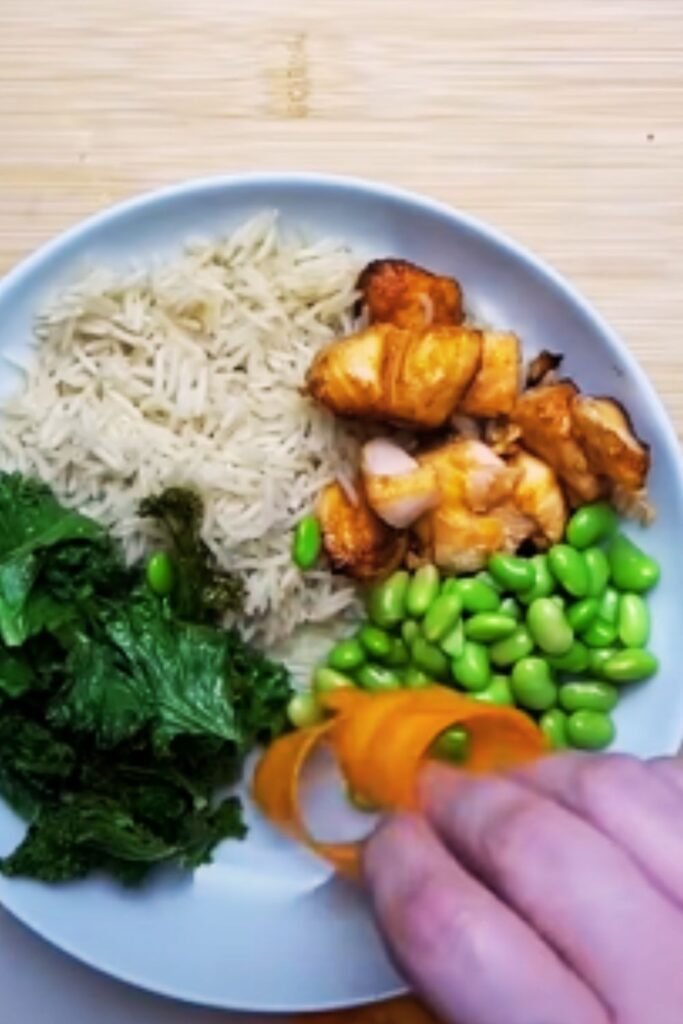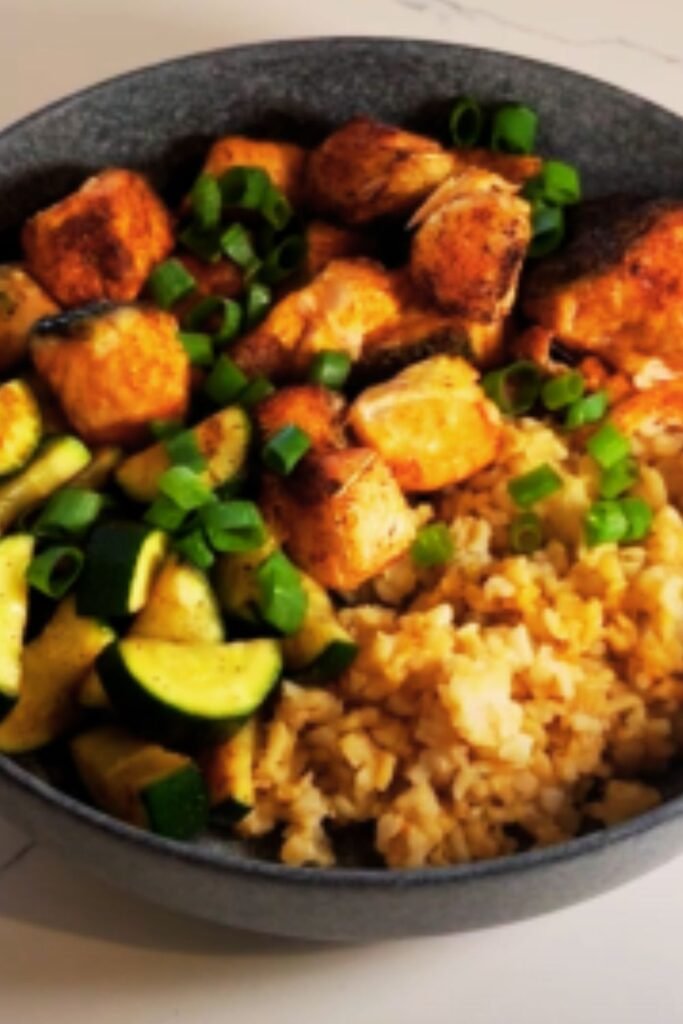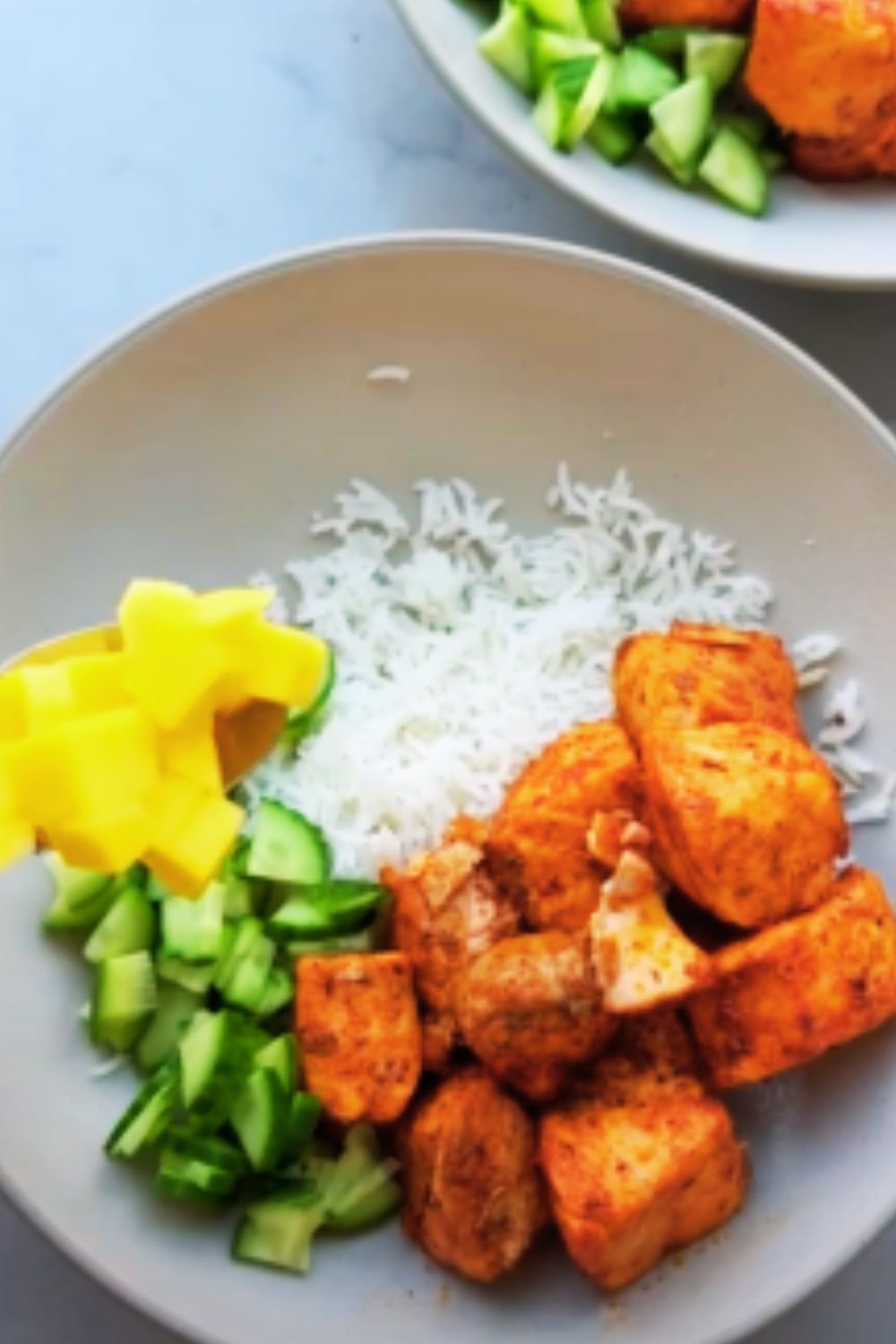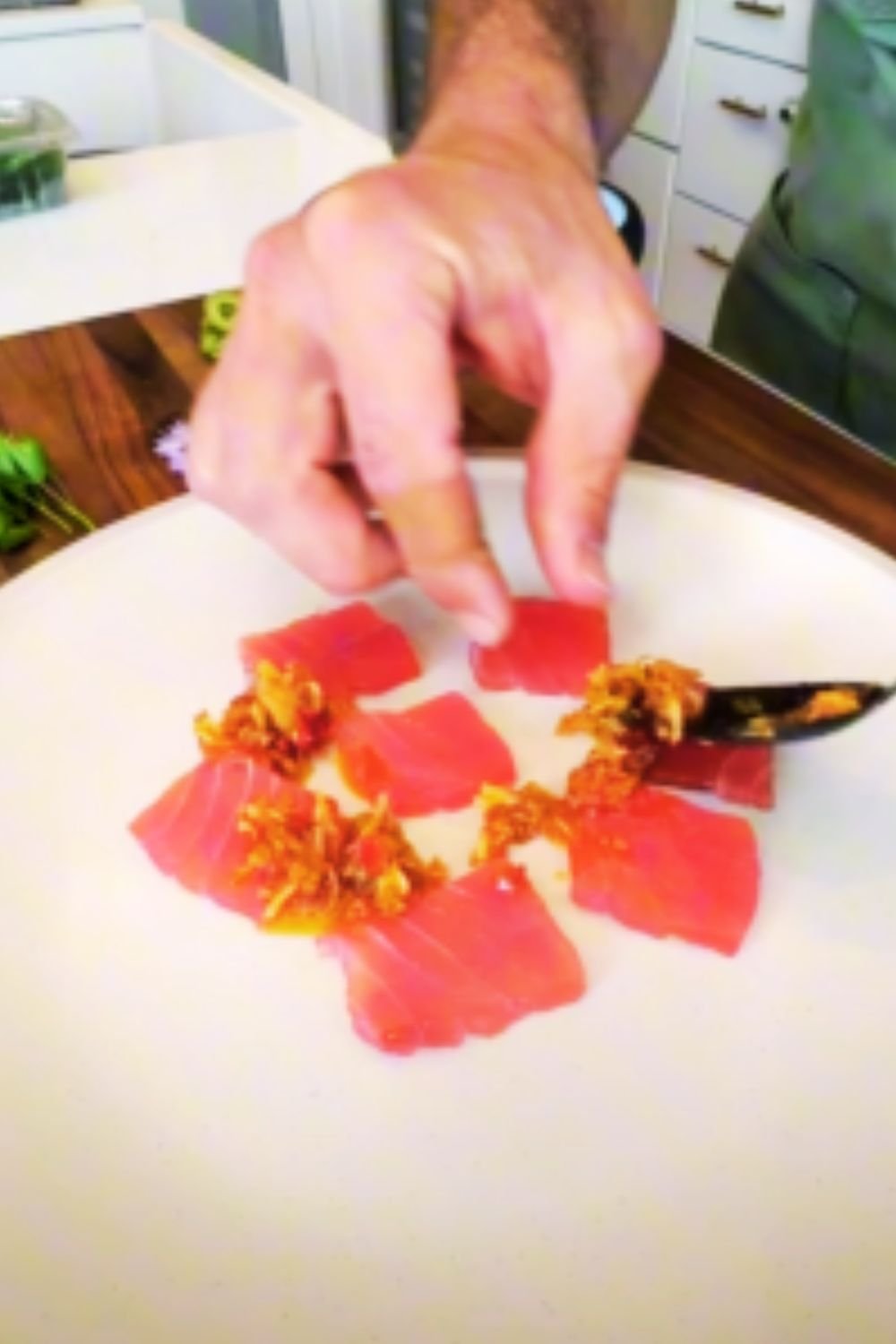There’s something magical about a well-crafted bowl meal—layers of flavor, texture, and nutrition all coming together in perfect harmony. As someone who values both convenience and nutrition, I’ve been perfecting my air fryer salmon bowl recipe for years, and I’m thrilled to share it with you today. This isn’t just any salmon bowl; it’s a carefully balanced masterpiece that delivers restaurant-quality results right in your own kitchen, in under 30 minutes.
Why You’ll Love These Air Fryer Salmon Bowls
I remember the first time I made these salmon bowls for a dinner party—my friends couldn’t believe they came from my kitchen rather than an upscale restaurant. The air fryer creates that perfect crispy exterior on the salmon while keeping the inside tender and moist. Paired with fluffy rice, crisp vegetables, and a zesty sauce, these bowls are a complete meal that satisfies on every level.
What makes these bowls truly special is their versatility. You can customize them based on the season, your dietary preferences, or simply what you have in your refrigerator. I’ve made countless variations over the years, and I’ll share my favorite combinations along with the core recipe.
Key Ingredients for Success
Before we dive into the recipe, let’s talk about selecting the perfect ingredients for your salmon bowls:
The Salmon
I can’t stress enough how important quality salmon is for this recipe. I prefer wild-caught salmon for its superior flavor and nutritional profile, but a good quality farm-raised salmon will work too. Look for:
- Freshness: The salmon should have a mild, ocean-like smell—never fishy
- Color: Bright, vibrant color (varies by species, but should look fresh)
- Texture: Firm to the touch, not mushy
- Thickness: Even thickness pieces (about 1-1.5 inches thick) cook most evenly
I usually budget for 4-6 ounces of salmon per person, which provides a satisfying portion without overwhelming the bowl.
The Base
While rice is my go-to base for these bowls, I’ve experimented with numerous alternatives:
- White rice: Jasmine or basmati rice offers a fragrant foundation
- Brown rice: For extra fiber and a nutty flavor
- Quinoa: Protein-packed alternative with a pleasant texture
- Cauliflower rice: Perfect low-carb option
- Soba noodles: For an Asian-inspired twist
Whatever base you choose, I recommend cooking it with a bit of salt and sometimes broth instead of water to infuse more flavor from the beginning.
The Vegetables
The beauty of these bowls is the colorful array of vegetables you can include. I aim for a minimum of three different vegetables with varying textures:
- Raw vegetables: Sliced cucumber, shredded carrots, thinly sliced radishes
- Quick-pickled vegetables: Red onions, jalapeños, or cabbage
- Roasted vegetables: Sweet potatoes, bell peppers, or broccoli
- Leafy greens: Spinach, kale, or arugula
The Sauce
The sauce ties everything together, and I often make extra because it’s just that good. My go-to sauce options include:
- Miso-ginger sauce: Umami-rich and warming
- Sriracha-mayo: Creamy with a spicy kick
- Cilantro-lime dressing: Bright and herbaceous
- Sesame-soy glaze: Rich and savory
Essential Equipment
While this recipe is fairly straightforward, having the right equipment makes a world of difference:
- Air fryer: Obviously the star of the show—I recommend one with at least 5-quart capacity
- Sharp knife: For prepping vegetables and portioning salmon
- Rice cooker or pot: For cooking your base perfectly
- Small food processor or blender: For smooth, well-emulsified sauces
- Meal prep containers: If you’re planning to make these bowls ahead of time

The Perfect Air Fryer Salmon Bowl Recipe
Now, let’s get into the details of creating these spectacular bowls!
Miso-Ginger Air Fryer Salmon Bowls
Serves 4
For the Salmon:
- 1 pound (about 16 oz) fresh salmon fillets, skin on
- 2 tablespoons white miso paste
- 1 tablespoon pure maple syrup
- 1 tablespoon rice vinegar
- 2 teaspoons freshly grated ginger
- 1 clove garlic, minced
- 1 tablespoon olive oil
- 1/2 teaspoon sea salt
- 1/4 teaspoon black pepper
For the Bowl Base:
- 2 cups uncooked jasmine rice
- 3 cups water
- 1/2 teaspoon salt
- 1 tablespoon rice vinegar (added after cooking)
For the Vegetables:
- 1 large cucumber, thinly sliced
- 2 medium carrots, julienned or spiralized
- 1 avocado, sliced
- 1 cup edamame, shelled and cooked
- 2 radishes, thinly sliced
- 1 cup purple cabbage, shredded
- 2 green onions, sliced diagonally
For the Quick-Pickled Red Onions:
- 1 medium red onion, thinly sliced
- 1/2 cup rice vinegar
- 1 tablespoon sugar
- 1/2 teaspoon salt
For the Miso-Ginger Sauce:
- 3 tablespoons white miso paste
- 2 tablespoons rice vinegar
- 1 tablespoon maple syrup
- 1 tablespoon soy sauce (low-sodium)
- 1 tablespoon sesame oil
- 1 tablespoon freshly grated ginger
- 1 clove garlic, minced
- 2-3 tablespoons water (to adjust consistency)
For Garnish:
- 2 tablespoons toasted sesame seeds
- 1/4 cup fresh cilantro, chopped
- 1 tablespoon furikake seasoning (optional)
- Lime wedges for serving
Instructions:
Step 1: Prepare the Pickled Onions
I like to start with this step because the longer the onions sit, the more flavor they develop.
- Place thinly sliced red onions in a glass jar or container.
- In a small bowl, whisk together rice vinegar, sugar, and salt until dissolved.
- Pour the mixture over the onions, ensuring they’re fully submerged.
- Let sit at room temperature while you prepare the rest of the components (at least 30 minutes) or refrigerate for up to a week.
Step 2: Cook the Rice
- Rinse rice under cold water until water runs clear.
- Combine rice, water, and salt in a rice cooker or medium pot.
- If using a rice cooker, turn it on and follow manufacturer’s instructions.
- If using a pot, bring to a boil, then reduce heat to low, cover, and simmer for 15-18 minutes until water is absorbed.
- Remove from heat, keep covered, and let steam for 10 minutes.
- Fluff with a fork and stir in rice vinegar.
Step 3: Prepare the Salmon Marinade
- In a bowl, whisk together miso paste, maple syrup, rice vinegar, grated ginger, minced garlic, olive oil, salt, and pepper until smooth.
- Cut salmon into 4 equal portions if not already portioned.
- Pat salmon dry with paper towels.
- Coat salmon pieces thoroughly with the marinade, cover, and refrigerate for 15-30 minutes (if you have time—if not, you can proceed immediately).
Step 4: Air Fry the Salmon
- Preheat your air fryer to 380°F (190°C) for 3-5 minutes.
- Lightly spray the air fryer basket with cooking oil spray.
- Place salmon pieces in the air fryer basket, skin side down, ensuring they don’t overlap.
- Cook for 7-10 minutes, depending on thickness. The salmon should flake easily with a fork but still be slightly pink in the center.
- No need to flip the salmon during cooking—this ensures the marinade stays on top and creates a delicious glaze.
Step 5: Make the Miso-Ginger Sauce
- In a small blender or food processor, combine all sauce ingredients except water.
- Blend until smooth.
- Add water gradually until you reach your desired consistency—I prefer it thick enough to coat the back of a spoon but pourable.
- Taste and adjust seasoning if needed.
Step 6: Prepare the Vegetables
- While the salmon is cooking, prepare all your vegetables.
- If using edamame, ensure it’s properly cooked and cooled.
- Slice avocado just before assembling to prevent browning.
Step 7: Assemble the Bowls
- Divide the cooked rice among four bowls.
- Arrange the vegetables in sections around the perimeter of each bowl.
- Place the air-fried salmon in the center.
- Drizzle generously with the miso-ginger sauce.
- Top with pickled red onions, sesame seeds, cilantro, and furikake (if using).
- Serve with lime wedges on the side.

Nutritional Information
If you’re tracking your macros or just curious about what you’re eating, here’s a detailed nutritional breakdown of these salmon bowls:
| Nutrient | Amount per Serving | % Daily Value* |
|---|---|---|
| Calories | 580 | – |
| Total Fat | 23g | 29% |
| Saturated Fat | 3.5g | 17% |
| Trans Fat | 0g | – |
| Cholesterol | 62mg | 21% |
| Sodium | 820mg | 36% |
| Total Carbohydrate | 64g | 23% |
| Dietary Fiber | 7g | 25% |
| Total Sugars | 8g | – |
| Protein | 30g | 60% |
| Vitamin D | 11mcg | 55% |
| Calcium | 120mg | 9% |
| Iron | 3mg | 17% |
| Potassium | 980mg | 21% |
| Omega-3 Fatty Acids | 1,500mg | – |
*Percent Daily Values are based on a 2,000 calorie diet
Variations to Try
Over the years, I’ve created countless variations of this basic formula. Here are some of my favorite combinations that you might enjoy:
Mediterranean-Inspired Salmon Bowl
- Salmon seasoning: Lemon, garlic, oregano, and olive oil
- Base: Quinoa mixed with chopped parsley
- Vegetables: Cherry tomatoes, cucumber, kalamata olives, red onion
- Sauce: Greek yogurt tzatziki
- Garnish: Crumbled feta cheese, lemon wedges
Teriyaki Salmon Bowl
- Salmon seasoning: Homemade teriyaki glaze
- Base: Brown rice
- Vegetables: Steamed broccoli, sliced bell peppers, shredded carrots
- Sauce: Extra teriyaki sauce
- Garnish: Sliced green onions, toasted sesame seeds, nori strips
Spicy Southwest Salmon Bowl
- Salmon seasoning: Chili powder, cumin, lime zest
- Base: Cilantro-lime rice
- Vegetables: Black beans, corn, diced tomatoes, avocado
- Sauce: Chipotle-lime crema
- Garnish: Chopped cilantro, lime wedges, pickled jalapeños
Low-Carb Salmon Bowl
- Salmon seasoning: Dill, lemon, garlic
- Base: Cauliflower rice sautéed with olive oil
- Vegetables: Roasted asparagus, mushrooms, spinach
- Sauce: Lemon-dill Greek yogurt sauce
- Garnish: Lemon zest, fresh dill sprigs

Tips for Perfect Air Fryer Salmon Every Time
After making this recipe countless times, I’ve discovered several tips that make a significant difference:
Temperature Matters
Always let your salmon sit at room temperature for 15-20 minutes before air frying. This ensures even cooking and prevents the dreaded dry exterior/raw interior problem.
Don’t Overcrowd
Make sure your salmon pieces have plenty of space around them in the air fryer basket. If they’re too crowded, they’ll steam rather than “air fry,” and you won’t get that wonderful exterior texture.
The Flip Question
Many recipes call for flipping halfway through, but I’ve found that with salmon, it’s better not to flip. The marinade forms a beautiful glaze on top, and flipping can cause it to stick to the basket and fall off.
Checking for Doneness
The FDA recommends cooking salmon to an internal temperature of 145°F (63°C), but I find this often leads to overcooked salmon. I prefer to cook mine to about 135°F (57°C) for medium doneness, which keeps it moist and tender. The residual heat will bring it up a few more degrees as it rests.
Let it Rest
Just like with other proteins, letting your salmon rest for a few minutes after cooking allows the juices to redistribute, resulting in more flavorful and moist fish.
Make-Ahead and Storage Tips
These salmon bowls are perfect for meal prep! Here’s how I handle making them ahead:
For Meal Prep:
- Cook rice and refrigerate in an airtight container (up to 4 days).
- Prepare vegetables and store separately (up to 3 days).
- Make sauce and refrigerate (up to 5 days).
- The day you plan to eat, air fry fresh salmon and assemble your bowl.
If you want to prepare the salmon ahead too:
- Air fry the salmon as directed.
- Cool completely.
- Store in an airtight container (up to 2 days).
- Consume cold or gently reheat in the microwave on 50% power until just warmed through.
| Component | Refrigerator Storage | Freezer Storage | Reheating Instructions |
|---|---|---|---|
| Cooked Rice | 4 days | 2 months | Microwave with splash of water |
| Air Fried Salmon | 2 days | Not recommended | 50% power in microwave |
| Cut Vegetables | 3-4 days | Not recommended | No reheating needed |
| Pickled Onions | 2 weeks | Not recommended | No reheating needed |
| Miso-Ginger Sauce | 5 days | 1 month | Thaw in refrigerator |
Serving Suggestions
For a complete dining experience, consider these serving suggestions:
- Appetizer: Start with a light miso soup to complement the flavors in the main dish
- Side: A small seaweed salad adds texture and umami flavor
- Drink pairings: Sparkling water with cucumber slices, green tea (hot or iced), or a citrus-infused water
- Dessert: Keep it light with fresh fruit like mango or pineapple, or green tea ice cream
Common Questions and Answers
Over the years, I’ve received many questions about this recipe. Here are the most common ones:
Q: Can I use frozen salmon for this recipe? A: Yes, but you’ll need to fully thaw it first. Pat it very dry before applying the marinade, as excess moisture will prevent proper browning.
Q: I don’t have an air fryer. How else can I cook the salmon? A: You can bake it in a conventional oven at 400°F (200°C) for 12-15 minutes, or pan-sear it in a hot skillet for 3-4 minutes per side.
Q: Is there a substitute for white miso paste? A: While nothing perfectly replicates miso’s unique flavor, you can substitute with a combination of tahini and soy sauce (1:1 ratio) plus a pinch of sugar for a similar umami-rich effect.
Q: How can I make this recipe dairy-free? A: Good news! This recipe is already dairy-free as written.
Q: Can I prepare this for someone with a sesame allergy? A: Absolutely. Simply omit the sesame oil in the sauce and replace with olive oil, and skip the sesame seeds as garnish.
Q: How can I add more protein to this bowl? A: While the salmon provides excellent protein, you can add a soft-boiled egg or extra edamame for even more.
Q: What can I use instead of rice for a grain-free option? A: Besides cauliflower rice, you can use zucchini noodles, sweet potato rice (grated sweet potato lightly sautéed), or a bed of mixed greens.
Q: My salmon skin always sticks to the air fryer basket. How can I prevent this? A: Make sure to spray the basket with oil before adding the salmon. Alternatively, you can place the salmon on a small piece of parchment paper with holes poked in it to allow air circulation.
Final Thoughts
There’s something deeply satisfying about creating a balanced, nutritious meal that’s also bursting with flavor. These air fryer salmon bowls have become a staple in my kitchen not just because they’re healthy, but because they’re genuinely delightful to eat.
What I love most about this recipe is its flexibility—it evolves with the seasons, adapts to what I have on hand, and never fails to impress, whether I’m cooking for just myself or hosting friends. The air fryer makes achieving perfectly cooked salmon accessible to anyone, regardless of cooking experience.
If you’re new to bowl meals or cooking salmon, this recipe is an excellent place to start. And if you’re a seasoned cook looking to expand your weeknight dinner rotation, I think you’ll find these bowls offer endless opportunities for creativity and customization.
I’d love to hear about your experience making these bowls—especially any creative variations you discover along the way. Happy cooking!
Recipe Card Summary
| Air Fryer Salmon Bowls | |
|---|---|
| Prep Time: 20 minutes | Cook Time: 10 minutes |
| Total Time: 30 minutes | Servings: 4 |
| Difficulty: Medium | Cuisine: Fusion |
| Calories: 580 per serving | Protein: 30g per serving |
Tag this recipe for later: #AirFryerRecipes #SalmonBowls #HealthyDinner #MealPrep #QuickMeals

